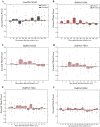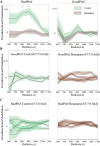Effect of reward on electrophysiological signatures of grid cell population activity in human spatial navigation
- PMID: 34880356
- PMCID: PMC8654941
- DOI: 10.1038/s41598-021-03124-y
Effect of reward on electrophysiological signatures of grid cell population activity in human spatial navigation
Abstract
The regular equilateral triangular periodic firing pattern of grid cells in the entorhinal cortex is considered a regular metric for the spatial world, and the grid-like representation correlates with hexadirectional modulation of theta (4-8 Hz) power in the entorhinal cortex relative to the moving direction. However, researchers have not clearly determined whether grid cells provide only simple spatial measures in human behavior-related navigation strategies or include other factors such as goal rewards to encode information in multiple patterns. By analysing the hexadirectional modulation of EEG signals in the theta band in the entorhinal cortex of patients with epilepsy performing spatial target navigation tasks, we found that this modulation presents a grid pattern that carries target-related reward information. This grid-like representation is influenced by explicit goals and is related to the local characteristics of the environment. This study provides evidence that human grid cell population activity is influenced by reward information at the level of neural oscillations.
© 2021. The Author(s).
Conflict of interest statement
The authors declare no competing interests.
Figures





Similar articles
-
Hexadirectional Modulation of Theta Power in Human Entorhinal Cortex during Spatial Navigation.Curr Biol. 2018 Oct 22;28(20):3310-3315.e4. doi: 10.1016/j.cub.2018.08.029. Epub 2018 Oct 11. Curr Biol. 2018. PMID: 30318350
-
Grid-like hexadirectional modulation of human entorhinal theta oscillations.Proc Natl Acad Sci U S A. 2018 Oct 16;115(42):10798-10803. doi: 10.1073/pnas.1805007115. Epub 2018 Oct 3. Proc Natl Acad Sci U S A. 2018. PMID: 30282738 Free PMC article.
-
Hexadirectional Modulation of High-Frequency Electrophysiological Activity in the Human Anterior Medial Temporal Lobe Maps Visual Space.Curr Biol. 2018 Oct 22;28(20):3325-3329.e4. doi: 10.1016/j.cub.2018.09.035. Epub 2018 Oct 11. Curr Biol. 2018. PMID: 30318353
-
Grid coding, spatial representation, and navigation: Should we assume an isomorphism?Hippocampus. 2020 Apr;30(4):422-432. doi: 10.1002/hipo.23175. Epub 2019 Nov 18. Hippocampus. 2020. PMID: 31742364 Free PMC article. Review.
-
Ten Years of Grid Cells.Annu Rev Neurosci. 2016 Jul 8;39:19-40. doi: 10.1146/annurev-neuro-070815-013824. Epub 2016 Mar 9. Annu Rev Neurosci. 2016. PMID: 27023731 Review.
Cited by
-
Quantitative modeling of the emergence of macroscopic grid-like representations.Elife. 2024 Aug 30;13:e85742. doi: 10.7554/eLife.85742. Elife. 2024. PMID: 39212203 Free PMC article.
References
MeSH terms
LinkOut - more resources
Full Text Sources

